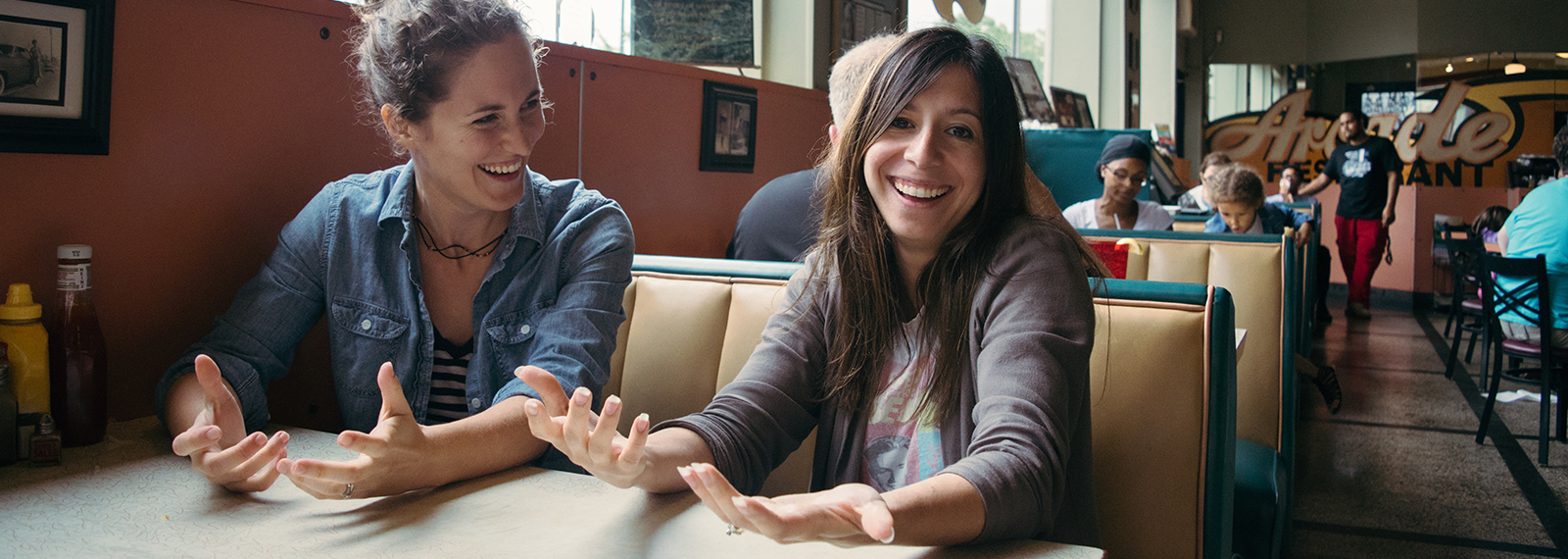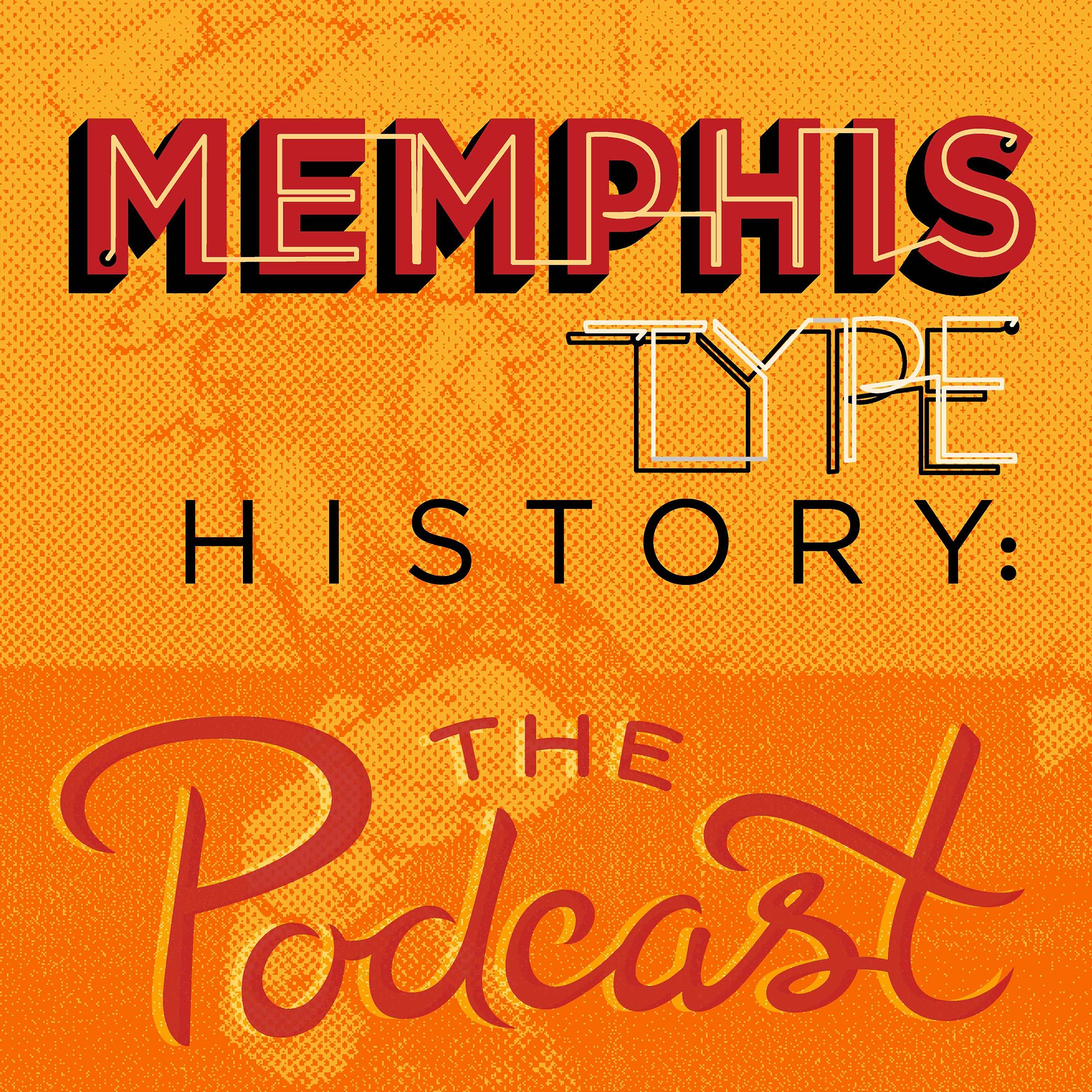Episodes
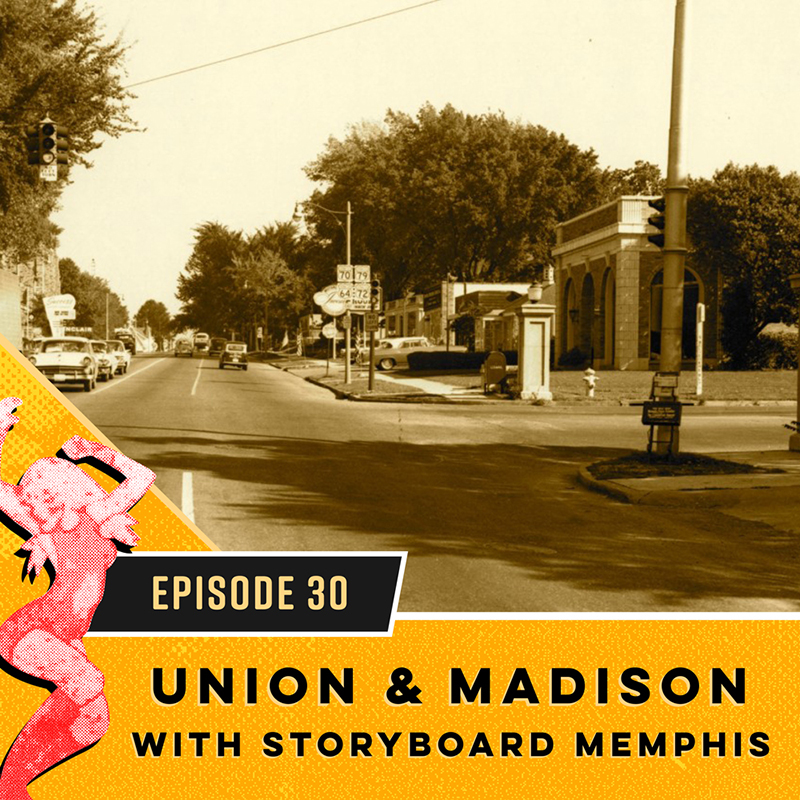
Sunday Jan 07, 2018
Union & Madison with Storyboard Memphis
Sunday Jan 07, 2018
Sunday Jan 07, 2018
In this episode of Memphis Type History: The Podcast, Caitlin chats with Mark Fleischer, the man behind Storyboard Memphis. We talk most about Union and Madison Avenues, so that makes this show another good ol' piece of Memphis street history for ya!
When Mark first came to Memphis, he luckily landed in Midtown, an area which sparked a deep interest in everything about Memphis history. Being relatively new to the city, he has an outsider point-of-view that helps him put a fresh eye on everything he learns about the city.
Mark pretty much immediately dives right into the longtime Memphis controversy over where the Midtown borders are... and Caitlin chose not to weigh in, not one bit. According to Mark, it comes down to iffy geographic borders and the "Midtown mindset," which he describes as activist, eclectic, and diverse... with a belief that they have a say in what happens in their neighborhood and how it develops.
Here's the really shocking thing for all you Midtowners – you weren't always in Midtown. In fact, just a few decades ago, you would've been living in East Memphis.
Elsewhere in this interview, Caitlin learned that Mark is extremely unimpressed by Union Avenue. But he still appreciates the rich history of the street anyway. Back in the 1880s/1890s, Crump held out on putting a trolley line on Union, even though they went up and down other main streets, in hopes of putting in city-owned tracks (rather than a line owned by private companies like the others were). Before this happened, the city created a new plan that called for the widening of Union so that it would be the main thoroughfare out east... and the Peabody-like feel of the street was changed.
In recent times, city planning desires are sounding like a look back to the early days of Union when it was walkable and bikeable, which it was until as recently as the '60s when it was widened again. We then discuss the aspects of Union that lack a sense of place... something that he feels got lost along the way in Union's long lifespan.
If you go down Union today, you can still find some older, 20s and 30s storefronts, but you've gotta look closely. There are few of them and they're off the road because this street was built for car traffic, which means parking areas (although, of course, these spots are not as plentiful for today's traffic). Listen in to find out which corners to go explore... both on and off of Union Ave!
Mark also talks about Madison and how it compares to Union... the former is curved to match the old street car lines that were installed there, as opposed to Union which was built for vehicle traffic. You get the same curvature in Cooper-Young too! Finally, come along with us for a meandering little trip down Madison, full of fits and starts that tell the history of Memphis and demonstrates a strong sense of place.
Last but not least is a charming story Mark uncovered about a late 1800s/early 1900s Memphis character, Christopher Hottum. Hottum owned a saloon at 119 Madison and was a major daredevil. He once jumped off a bridge because everyone said he'd die if he did it. He promoted the last legal bareknuckle fight in Mississippi, too. Why did Mark find out about him? His tax man asked for a history of his home, and lo' and behold, this guy built it! Hottum is just one example of what Mark calls the "mythic quality" of Memphis.
We end with a few fun rapid-fire questions that Mark handled like a total pro. You'll learn which Memphis neighborhood he'd stay in for all eternity, what Memphis street name he'd make his own, and more!
For full show notes, go to memphistypehistory.com/union
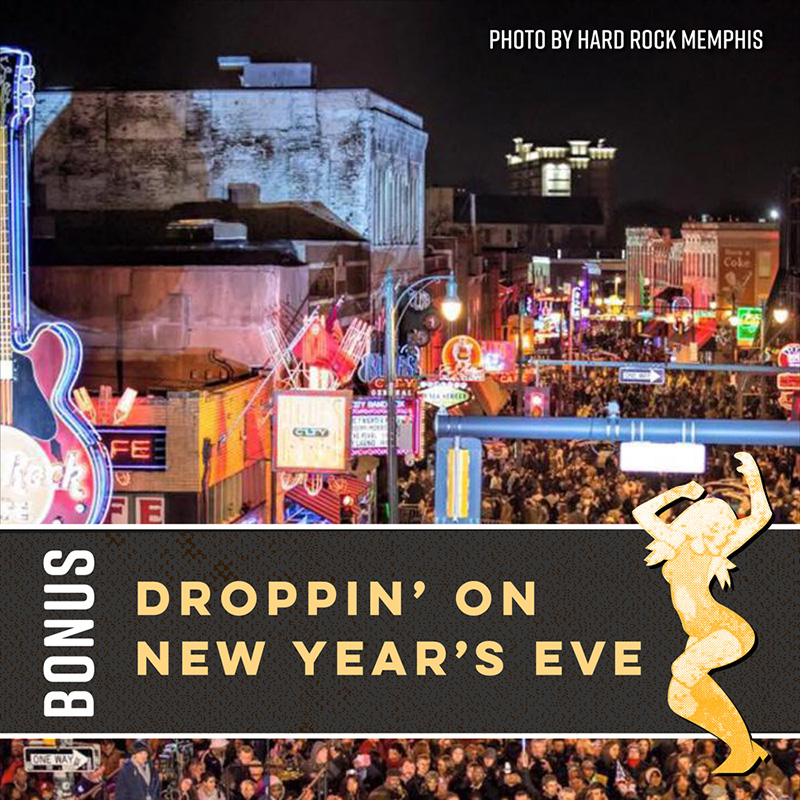
Monday Jan 01, 2018
Bonus Episode: Droppin' On New Year's Eve
Monday Jan 01, 2018
Monday Jan 01, 2018
This bonus episode provides you with the history behind the New Years Day Gibson guitar drop on Beale Street in Memphis, TN... and a listing of a few other drops in the USA.
For other bonus episodes, visit memphistypehistory.com/bonus

Monday Dec 25, 2017
Bonus Episode: Ice Skating at the Mall
Monday Dec 25, 2017
Monday Dec 25, 2017
This bonus episode features a listener who called and left a voicemail at Speakpipe about her time as a figure skater at the Mall of Memphis.
For full show notes and to listen to other bonus episodes, visit memphistypehistory.com/bonus
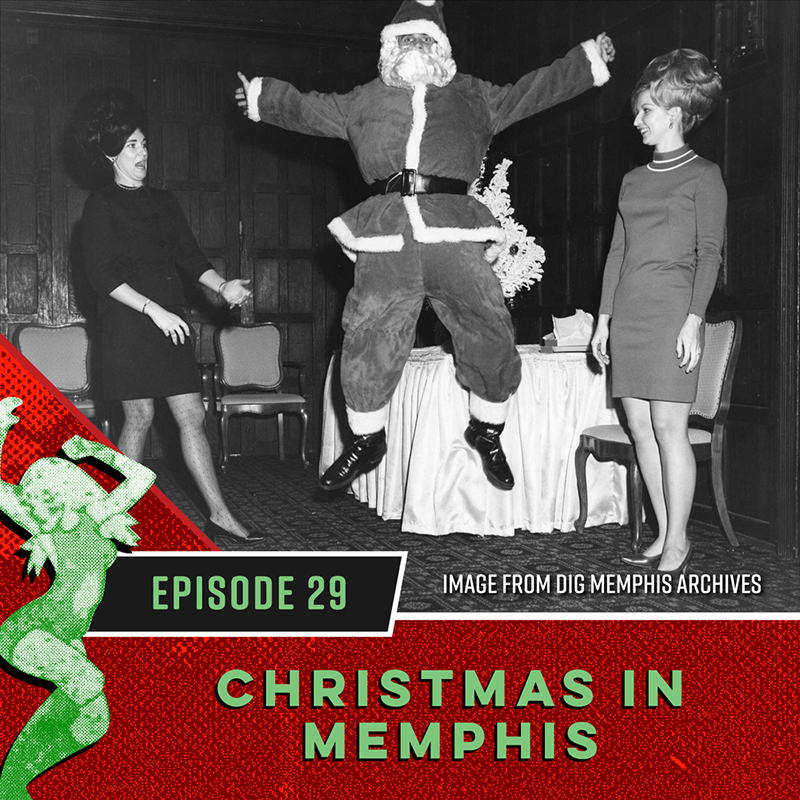
Sunday Dec 17, 2017
Christmas in Memphis
Sunday Dec 17, 2017
Sunday Dec 17, 2017
In this episode of Memphis Type History: The Podcast, we're talking all things Christmas in Memphis and sharing YOUR memories of this magical holiday. Hang your tinsel, grab your hot chocolate, and settle in for a jolly good time on this week's show!
The Enchanted Forest at Goldsmiths
Ask a longtime Memphian about Christmas and you’re sure to hear about the Enchanted Forest at Goldsmiths department store.
Goldsmiths was started in 1870 as a dry goods store on Beale Street by two German immigrant brothers, Jacob and Isaac, and their savings of $500. In 1895, it moved to Main Street. The store expanded into the Gayoso in 1952. The downtown store closed in 1993 and inside nowadays you will find the Center for Southern Folklore. Goldsmiths was very fancy for its time with its escalators, air conditioning, and merchandise arranged by departments. They even had a Christmas parade ten years before Macy’s did it.
The Enchanted Forest was inspired by the Disney "Small World" ride. It first opened in the bargain basement in 1960. Apparently there was a long tunnel from the parking garage to the store that had many strange and wonderful wares along the walls. At the end of the tunnel, one could find a bakery with seasonal gingerbread men. Busloads of children would arrive, giddy to be on a field trip and at the prospect of spotting Santa with his live reindeer. An electric train (or perhaps several) ran throughout the Enchanted Forest.
Memphis Santas
We hear several charming Santa memories on this episode and it was so fun to hear how everyone was sure that THEIR Santa was real!
For many years, Court Square was decorated as the North Pole and featured Santa's home. This magical Santa had a super secret way to discover the names, information, and what sort of gifts he could promise the children will receive that year. No matter what each child wished for, they all left with a tiny Coke bottle keychain!
Another Memphis Santa of note was Robert J. Morton, whose wife dared him to dress up as Santa and wave to passersby in 1968. It took off and so he became known for delighting children at his fully decked out home for two weeks during the Christmas season. His house on Parnassas was strung with hundreds of lights and Jingle Bells was playing. In his second year as Santa, about 300 children came by to visit Morton.
Overton Square
Christmas at Overton Square was a sight to behold. In 1976 those wild dudes who created the Square decided there should be snow. So they orchestrated a “Charles Dickens” Christmas – with blue skies and a blizzard that began as soon as the temperature hit 28 degrees. The snow came out of a snow-making machines connected to fire hydrants.
Carolers dressed like they were from the 1800s sang beneath lampposts wrapped in garland and tied with ribbons. The official city tree was located on in front of T.G.I. Fridays, of course. The big parade went right down Madison. Ice skaters crammed onto the rink that took over the entire street between Florence and Cooper.
Lots of Overton Square memories on this episode!
Mr. Bingle
Mr. Bingle was a well-loved Memphis snowman who worked as Santa’s assistant during Christmas with his charming ice cream cone hat, candy cane, and red ribbon complete with bells and holly. Mr. Bingle was imagined by Emile Alline in 1947 down in New Orleans. Having the initials M.B., which was shorthand for the Maison Blanche department store, he became their mascot.
He then gained larger fame when Mercantile Stores and Dillard's picked up the character. His most famous form in New Orleans was the 15-minute puppet show on Canal Street, where he also appeared in giant papier-maché form, voiced and puppeteered by Edwin "Oscar" Isentrout. This show, his TV and radio appearances, and charity events continued until Isentrout’s death in 1985. In Memphis, the Mr. Bingle shows were co-hosed by Miss Holly, played by Memphis advertising executive Joan White.
A 2004 there was a novel called Saving Mr. Bingle sold in Nola and Memphis, with proceeds going towards a gravestone for Isentrout's previously unmarked grave at Hebrew Rest No. 3 Cemetery in New Orleans. The stores also marketed the character by selling Mr. Bingle merch.
For full show notes, visit memphistypehistory.com/christmas.
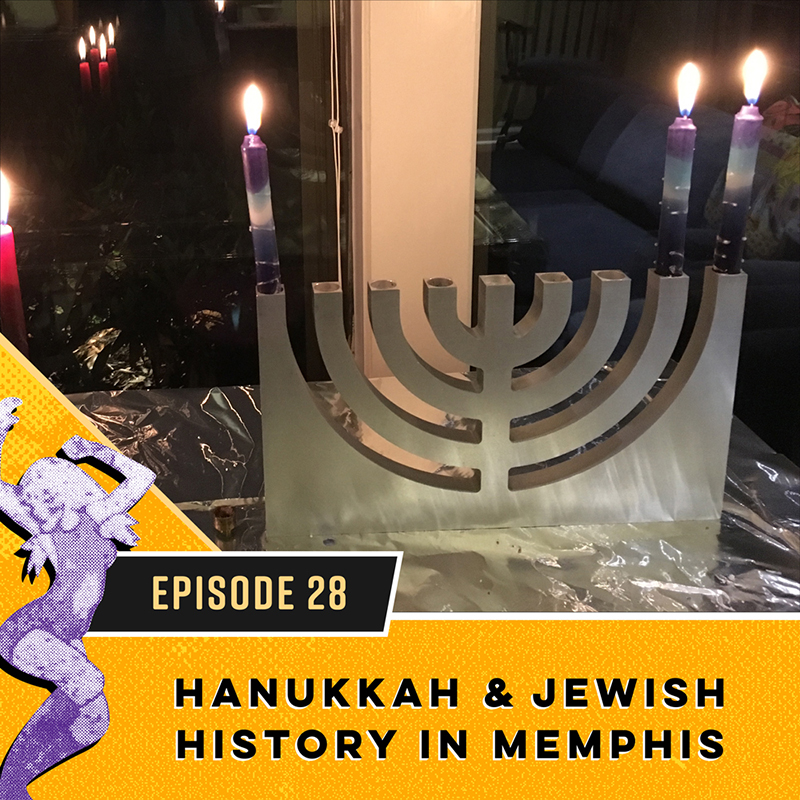
Sunday Dec 10, 2017
Hanukkah and Jewish History in Memphis
Sunday Dec 10, 2017
Sunday Dec 10, 2017
In this episode of Memphis Type History: The Podcast, Rebecca speaks with Lynnie Mirvis, a member of the Jewish Historical Society of Memphis and the Mid-South, to tell us about the meaning of Hanukkah. And while the intent was to learn all about the festival of lights and its history, we end up diving more into the history of Judaism and what the Jewish community looked like in Memphis throughout.
Learning about Lynnie
Lynnie, a Memphis native takes us back to her days going to a Jewish day school and let's us in on what a Bar Mitzvah is.. something Rebecca always wanted to be invited to. It's the age when a boy or girl enters true responsibility to the Jewish Culture. They are celebrated differently depending on what denomination. There is some difference in when that happens, though.
Reformed? Conservative? Orthodox?
She also spent some time explaining some of the finer points of Judaism. Whether Orthodox, Reformed, Conservative etc... to be Jewish is to be part of the Jewish people. It is a faith community. Before the 18th century there were no different forms of being Jewish. It was during the enlightenment age that reformation took place. We don't dive into the differences in much detail but we do learn there were different movements and we can find these different denominations in Memphis. This is where it starts to get really interesting for all you Memphis history buffs. You'll even find out what famous architect designed one of the orthodox synagogues here.
It all started in the Pinch
The Jewish community in Memphis started in the Pinch District downtown in the 1850's. Then moved in several different locations. First, to Washington and Fourth, then, North Parkway, and now in East Memphis. At one time, the site where Mississippi Boulevard Christian Church sits now was once a temple. You can even still see the golden dome if you look closely while driving down Poplar. It should be noted there are different synagogues for the different denominations in different locations.
One of the historical highlights was the beginning of the Jewish community center which is now occupied by another well-known facility. The Jewish Community Center started to give Jewish young people of all different denominations one place where they could come together to do various activities. There were swimming pools, basketball courts, dance classes, theatre, and various other community classes and meetings. You may now recognize this as the newly purchased annex building on the north side of the Turner Dairy. Today, the Jewish community center is in East Memphis near the synagogues.
Hanukkah is Here!
We also got spend some time talking about the imagery and stories of the tradition of Hanukkah. Lynnie told that it's actually not one of the biggest holidays on the Jewish calendar, but has become a special time in the U.S. One of the reasons: the lighting of the menorah has become such a beautiful symbol of the holiday season. You'll have to listen to get the full story and Lynnie's explanation of how the story is a metaphor including an Alexander the Great connection. There's also a really interesting story about one moment in history in which the Jewish people were demanded of another leader to give up their lights. You can listen to it all in this podcast episode.
To Be Jewish, Is to Be Thankful
Lynnie explained how at it's semantic root, the word "Jewish" actually means "Thankful". She talks about the origins of the word and, of course, another beautiful story to tie it all together. She even tells me about the thankful prayer that many Jewish people around the world start their day by reciting.
Her family came to Memphis from Poland to find a better life and likely to escape persecution. They started a store and an auto parts shop in 1941. On the other side of the family, they arrived from German in the late 1800's. That side of the family actually started the Jewish newspaper and print shop. It was located at a pretty well-known location right next to the Rendezvous. That building, unfortunately, is no longer standing.
Another location for her family's auto parts shop, Katz Brothers, used to occupy was the corner of Florence right by Overton Square. You can find the Magnolia Room, an event space, there now. They even lived above the shop there for many years. Some of her family members that escaped the holocaust came to this house as a place of refuge and then stayed in Memphis.
Being Jewish in Vollentine-Evergreen
Much of her childhood happened near the Orthodox Synagogue location not far from her house near the intersection of Hawthorne and Vollentine. You'll find a church there now in a building and land the occupy an entire city block. It almost looks like an old utility building or something like that. But in the 50s and 60s it was the orthodox shoal (another word for synagogue). She recalls growing up in the turbulent time of the civil rights movement and her holocaust-surviving cousins being appalled at some of the things that existed in Memphis at the time—segregation in department stores and in public places. She also talks about the what she was doing the moment she found out Dr. King had been assassinated. But maybe the most intriguing part of it is her talking about how her Jewish experience gave her a different perspective on the events of that time. You guessed it... you'll have to listen to hear, though.
The Jewish Historical Society of the Mid-South
Lynnie talked about being a member of the Jewish Society of the Mid-South which exists to preserve the stories of the jewish people in the region. She has been a members since the organization's founding in the 1980s. The collection they preserve is physically located at Temple Israel in East Memphis. They are especially interested in noting and keeping record of landmarks and buildings that have connections to the Jewish stories of Memphis.
Her Elvis Story
It turns out that Elvis' dentist was Jewish, his taylor was Jewish, and best of all, when Elvis was living in Lauderdale Courts, his neighbor was the head of a Jewish school. Apparently, the school leader would leave his record player on on sabbath to avoid breaking tradition. It is said, that the music Elvis heard had an impact on him. Details in the podcast including the strongest Jewish connection of all.
For full show notes go to memphistypehistory.com/hanukkah

Tuesday Dec 05, 2017
Let's Go to the Movies
Tuesday Dec 05, 2017
Tuesday Dec 05, 2017
In this episode of Memphis Type History: The Podcast, grab some popcorn because we take you to the neighborhood theater of Crosstown, a place that lives no more. Then learn the story behind Lloyd T. Binford, the man who played watchdog over Memphis cinema for many years.
The Crosstown Theater was built in the late 1940s and opened in May of 1951. It stood at N. Cleveland Street which is now occupied by a Jehovahs Witness Kingdom Hall. The theater had a 90 ft. vertical sign with the word crosstown. Sources say a mile of neon tubing was used in the marquee and vertical sign. At the time it was the largest neighborhood theater in Memphis, holding 1,400 seats. For perspective if you've ever eaten at The Magestic Grill on North Main Memphis, that was once a theater that held 1,000 seats.
In the 1960s and 1970s, Elvis Presley used to rent the theater out for all-night movie sessions.. although we learn that this wasn't anything new for Elvis and we even tell a short story about an encounter with Elvis at another theater with a gifting of a gold cup. The Crosstown Theater closed on May 5, 1976, but was then sold to Jehovah's Witnesses who were able to get a $1.3 million makeover thanks to a 100 percent volunteer workforce that was funded by donations.
Rebecca's only regret is moving to Memphis only 3 years after the vertical sign was removed and destroyed in 2005.
Now onto the man who kept Memphis AWAY from the movies...
Born in Duck Hill, MS, in 1869, Lloyd T. Binford left school in 5th grade to pursue different moneymaking schemes. Eventually, he became president of the Columbian Mutual Life Insurance Company in 1916 and moved to Memphis in 1925. There, he built the Columbia Mutual Tower, a 22-story white terra cotta building on Court Square (now known as the Lincoln America Tower).
Enter the Memphis Censor Board, created in 1921 with a mission to "censor, supervise, regulate, or prohibit any entertainment of immoral, lewd, or lascivious character, as well as performances inimical to the public safety, health, morals, or welfare." It was pretty much just a name with no action until Binford got ahold of it in 1928. Under Binford, the censor board would ban more Hollywood movies than any other city. It got so intense that folks started saying their films might get "Binfordized," and would even send their scripts in early to get Binford's approval early on.
What times of movies got “Binfordized?” Try anything containing train robberies. Or even King of Kings because it differed a bit from the Bible and the crucifixion aspect was too violent. And then there was The Woman They Almost Lynched, which wasn't shown in Memphis because Binford was simply against films featuring Jesse James. Anything Ingrid Bergman made was banned because she was having an affair with director Roberto Rossellini. And no Charlie Chaplin either "because of Chaplin's character and reputation," as quoted in the Chicago Daily Tribune. Memphians missed out on Rebel Without a Cause because Binford felt it promoted juvenile delinquency. He also banned films containing relationships between blacks and whites that he personally disagreed with, and often censored black performers' scenes altogether.
So what did Memphians do under the heavy weight all these movie bans? Well, many flocked to Mississippi and Arkansas to see those films advertised as “Banned in Memphis.” In fact, 15,000 Memphians went to Arkansas in 1928 to see Gloria Swanson's Miss Sadie Thompson.
Binford resigned his position several times due to bad health, but kept getting called back to the position by supporters. He died the year after actually retiring and is buried at Elmwood. The censorship law that gave Binford so much power was only declared unconstitutional in 1965.
For full show notes and pictures, visit memphistypehistory.com/binfordized
Support the show at patreon.com/memphistypehistory and get bonus content like our weekly blooper reel, digital wallpaper featuring Rebecca's artwork, t-shirts, signed books, and more!
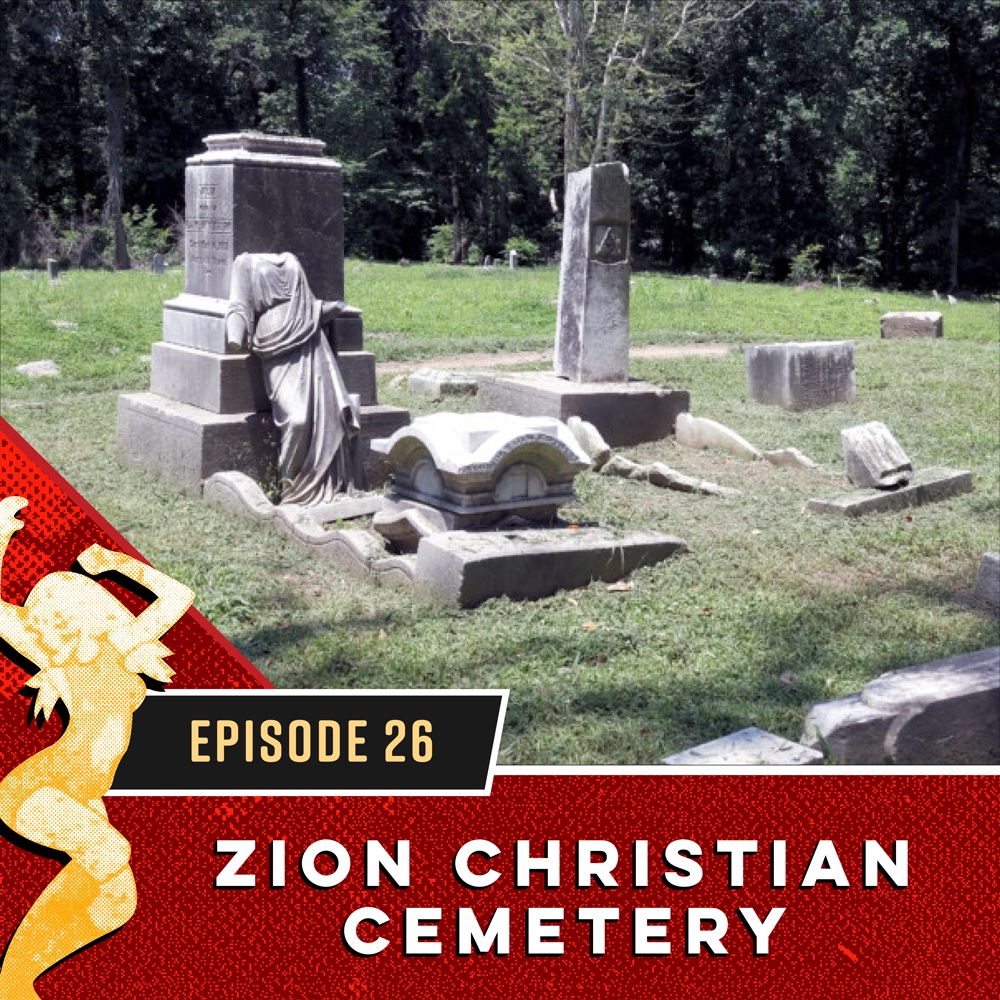
Tuesday Nov 28, 2017
Zion Christian Cemetery
Tuesday Nov 28, 2017
Tuesday Nov 28, 2017
In this episode of Memphis Type History: The Podcast, Caitlin tells Rebecca the history behind Memphis' oldest African-American graveyard: Zion Christian Cemetery. She was taken to the site by Tramica Morris (whose home we toured in our 16th episode – A Tour of Glenview Historic District). There are many notable Memphians buried there and ever so many ties to important moments of Memphis history... and we're happy to report that efforts to revitalize it are underway.
The 15-acre Zion Christian Cemetery is located on the north side of the 1400 block of S. Parkway East. In 1990 is was added onto the National Register of Historic Places and there are likely 30,000 people buried there. Back in 1873, the United Sons of Zion, an African-American fraternal organization founded by freed slaves, purchased this land.
It took three years for it to be turned into the final resting place for so many when Reverend Morris Henderson, the founding pastor of Beale Street Baptist Church got it officially established as a cemetery. This church was the first brick church in the Midsouth built by and for African Americans and the congregation was made up of freed slaves.
In my various pieces of research for blog posts and podcast episodes, I've come across the quick mention that people used to believe the yellow fever was somehow started by African Americans through voodoo or somesuch. And although it was believed that the black community was immune to Yellow Fever, they were, in fact, not totally so. While most white citizens fled Memphis in the fever, many African Americans stayed and nursed the sick. But when they died, they couldn’t be buried at the other cemeteries in city so they would be laid to rest in Zion – so this is why there are so many people buried there.
The victims of the Peoples Grocery Lynching in 1892 are buried at Zion Christian Cemetery.
Thomas Moss, Calvin McDowell, and William Stewart,were brutally murdered by a mob of white men (with the press present to take down all the details) because their grocery store was more popular and prosperous than the white guy's store in the same neighborhood. I go into more detail on the show, but I still recommend you visit the links at the bottom of the show notes to learn more about it. Moss' murder would inspire Ida B. Wells' international anti-lynching crusade.
Julia Hooks is also buried in Zion Christian Cemetery. She was deeply involved in young people in the city as an officer of the Juvenile Court, a teacher, and a school principal. Her sons, Henry and Robert Hooks, owned the famous Hooks Brothers Photographers. This business was the second oldest continuously operating black business in Memphis. They were extremely influential in recording African American life in the 20th century, and even took the only known studio portrait of blues musician Robert Johnson. Their studio was located at 162 Beale which is now King's Palace Café (and has been left largely intact apparently).
Julia Hooks' grandson was Benjamin L. Hooks, a name you likely recognize because the main library is named for him. Dr. Hooks was a major civil rights movement leader and was executive director of the NAACP from 1977 to 1992.
There are many other notable African American community members buried here in Zion Christian Cemetery, and you'll need to tune in and hear about them all!
The cemetery thrived up until the 1920s, by which time many of the original shareholders had passed away... so it was supported by church collections. Then by the '60s it had pretty much been abandoned. It was so overgrown that many people didn't even know that such a historic site lay underneath all the trees and weeds.
In 2005, the Zion Community Project was formed to clean out and preserve the history here. On the day I visited, a lot of clearing out what going on. Future plans include identifying those laid to rest there, creating roads and walkways for better navigation through the cemetery, and documenting the stories of people buried there.
For full show notes, links, and pictures visit memphistypehistory.com/zion
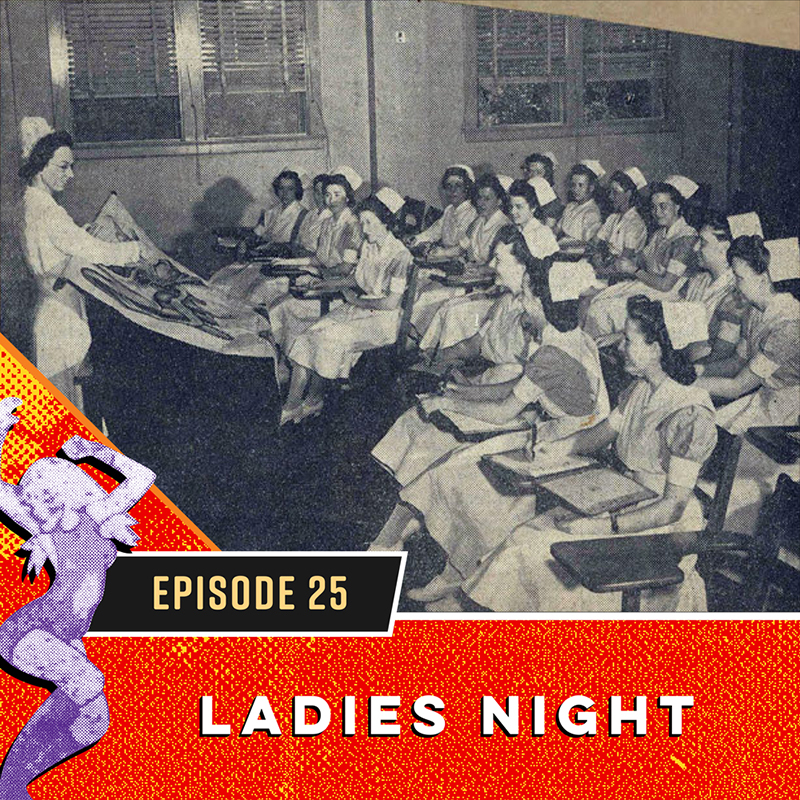
Wednesday Nov 22, 2017
Ladies Night
Wednesday Nov 22, 2017
Wednesday Nov 22, 2017
In this episode of Memphis Type History: The Podcast, Caitlin and Rebecca take each and every one of you out for Ladies Night! And guess what? It's a two-for-one special tonight because they each share the story of a Memphis lady they love.
First, Rebecca makes Caitlin play a game of "Name That Tune." Well, sort of. We're not really sure how the game show worked and we for sure don't play the right way. But you can play along with us if you dare! But beware that Rebecca gets REALLY bossy about it.
All of these shenanigans lead us into learning all about Estelle Axton, who grew up on a farm and moved to Memphis to be a teacher. But then in 1958, fate came upon her when her brother, Jim Stewart, asked her to start Satellite Records with him. Estelle and her husband re-mortgaged their home and created their first big musical hit. This caught the attention of an LA label that already owned that name. So the siblings combined the first two letters of their last names to create... drum roll please... Stax!
Every recording studio is known for its unique sound, which is greatly affected by the physical build of the studio. At Stax, the floor was slanted because they had to set up shop in a theater. And voilà, the Stax sound was created! The original label's name lived on in the Satellite Record Shop that Estelle created in the former concession stand to help pay rent and gain insight into which records would sell best. Along with much success with Stax, Estelle also went on to become huge in the music industry, both in Memphis and globally.
Next up, Caitlin brings the Wild West to Memphis with a story that bundles up in one inspirational woman all the things we love: Memphis, an iconic sign, and, as stated, the Wild West. In 1927, 21-year-old Evelyn Estes (aka "Calamity Jane's Little Sister) set off alone with just a horse and her dog, Kip, to reach the Pacific Ocean in California. She took very little with her except a travel journal, intending to rely solely on the kindness of strangers. Caitlin details the high points of Evelyn's journey, which includes things like how she delivered a baby, ran slap into pioneer life (straight up Oregon Trail stuff, y'all), saw several famous people, and lots more.
For those who particularly love the ladies of the Wild West, we also have a nice little sidebar in this episode about Calamity Jane herself, too! We also cover a bit of the history behind our surprise iconic sign encountered by Evelyn herself on her way to the ocean... no spoilers here, though!
Evelyn didn't stop being awesome at 22. She also was a WWII nurses' aid, made B29s, worked with children in the John Gaston Hospital. Being the total boss she was, Evelyn lived on to the age of 103.
For full show notes, go to memphistypehistory.com/ladies
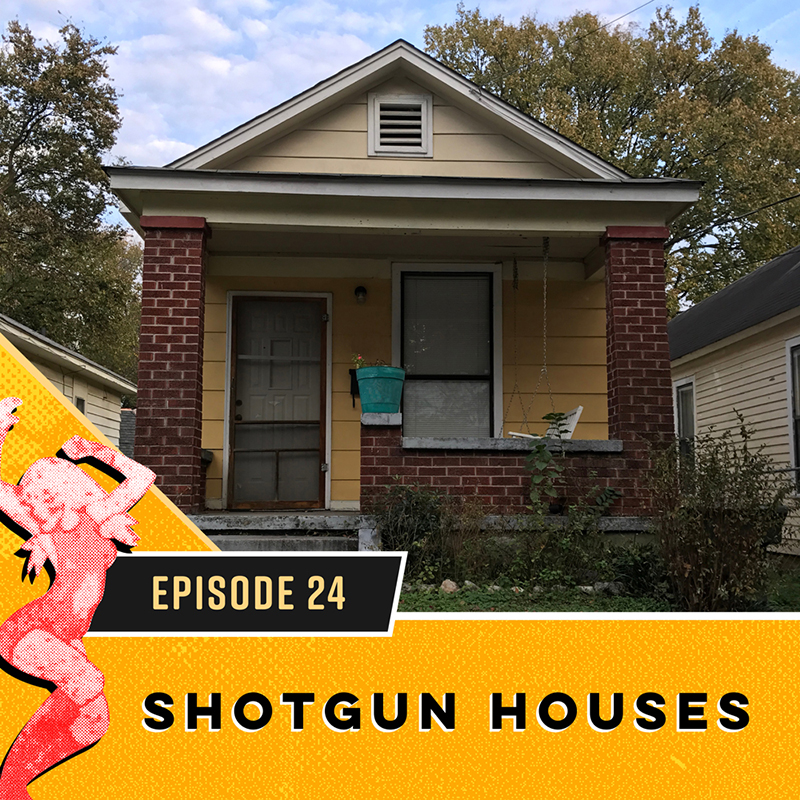
Monday Nov 13, 2017
Shotgun Houses
Monday Nov 13, 2017
Monday Nov 13, 2017
In this episode of Memphis Type History: The Podcast, Caitlin educates Rebecca on Midtown Memphis' favorite type of home – the quintessentially Southern shotgun house.
Shotgun houses can be found all over the south, including Memphis. First up, let's understand the format of a shotgun house. It's narrow – just one room wide – and would be at least three rooms deep to count. Typically, the first room was a living room, then bedrooms, and then the kitchen at the back. The original shotgun house would have been 12-feet wide with a single window beside the front door. Later in time, as we'll see, this design will change. The name comes from the fact that a gun could be fired at the front door and the bullet would travel straight out the back door without hitting anything, since there's no hallway.
Where these original shotgun houses came from remains a mystery. Some say they're African floor plans that were brought to Haiti by slaves in the colonial era. The first ones documented in the U.S. were built in New Orleans in the 1840s. They then began spreading throughout urban areas. The "second wave" of shotgun home building made it to Memphis, so the ones built here in the 1860s and 70s have fancier architectural elements than the first wave houses. Finally, the "third wave" came about in the late 1880s during industrialization. This time period featured simplified shotgun homes constructed as working class rental units.
Because of constant changes throughout time, it's uncertain that all of these Memphis shotgun house neighborhoods still exist, so explore at your own risk :)
659 Jennette Place was the site of a famous Memphis shotgun house, as it's where blues musician W.C. Handy wrote songs like "Yellow Dog Blues" and "Beale Street Blues." It's now at 352 Beale Street as a museum.
406 Lucy Avenue is where you can find the shotgun house Aretha Franklin was born in... and rumor has it that her bathtub is still in there. Since the time of this episode's recording, it seems that renewed efforts are underway to restore the home for history.
In a book on Memphis architecture, Wells Avenue was listed as a wealth of shotgun houses, the best in the city. But its National Register of Historic Places designation was removed in 2014 so I'm wondering if they are still there. Lost Memphis found two shotgun homes there in 2014. These are/were built around the turn of the century and are closer to 25 feet across... the same street feature/d 1920s bungalows as well.
Belz Court was constructed in 1936 to house African American families working in Philip Belz's North Memphis Industrial District. There were a dozen shotgun duplexes there on either side of a "pedestrian court" – no driveways or anything for parking because the planners expected everyone would just walk to work. Because of it's old-fashioned design, only about three of them were left in 2014 because they just aren't very practical for modern families. Lost Memphis also went there to check out what's left.
For full show notes, visit memphistypehistory.com/shotgun
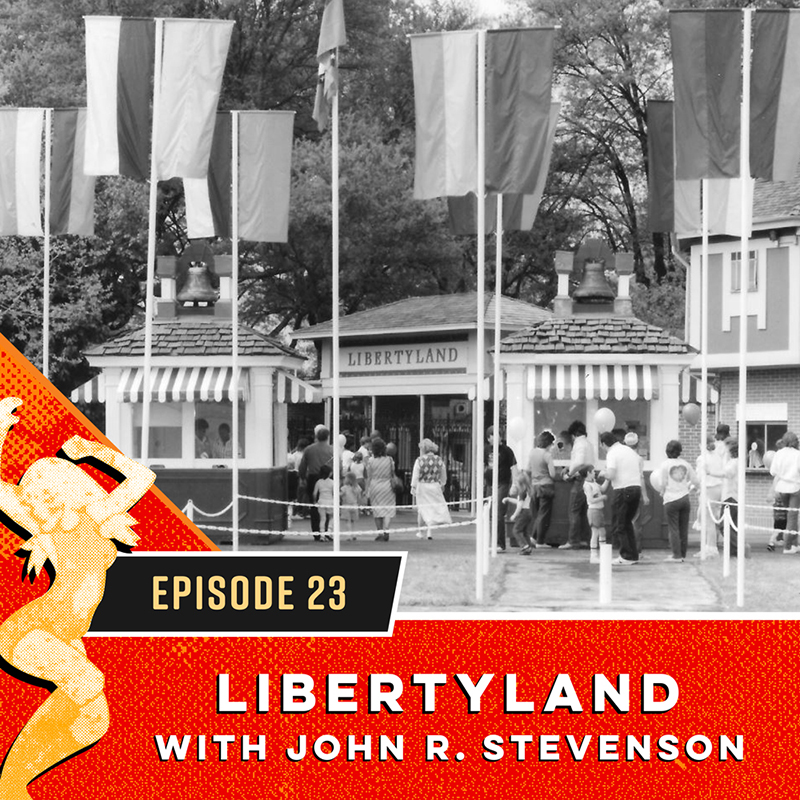
Monday Nov 06, 2017
Libertyland with John R. Stevenson
Monday Nov 06, 2017
Monday Nov 06, 2017
In this episode of Memphis Type History: The Podcast, Caitlin chats with John R. Stevenson all about everyone's favorite bundle of fun—Libertyland! John just published a book about the park and we dive right into all the weird and wonderful things about this historic Memphis spot.
For full show notes, go to memphistypehistory.com/libertyland
